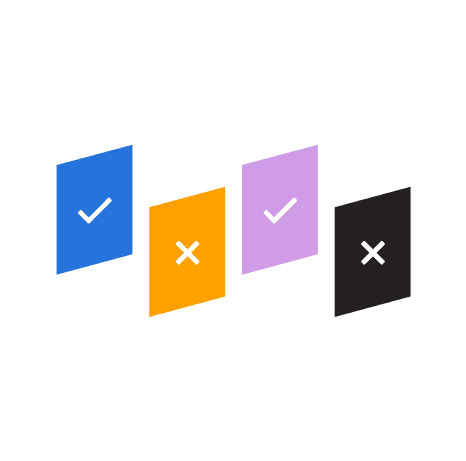What is Proposal Automation?
Proposal automation, also known as bid automation, uses technology to conduct activities throughout the proposal management process, reducing the need for human intervention. When a company, organization, or business needs to outsource a certain service or project, they raise a Request for Proposal (RFP), Request for Quote (RFQ), or Request for Information inviting bids from service providers or businesses to submit a proposal explaining why they are best suited for the task.
The businesses that respond to these RFXs must prepare and submit a well-researched, well-written proposal to be shortlisted. It is a time-consuming task that can be stressful and can determine the success or failure of a business.
The lifecycle of a proposal starts from choosing the RFX to apply for, and covers developing the proposal, submitting it, tracking its progress post-submission, and promoting the achievement after winning the bid. There is a need to have a proposal management system to deal with the entire lifecycle of the proposal as this increases the likelihood of winning the RFX.
Professional proposal developers are well-versed in the process of proposal management and may have automated some aspects of their process to reduce their workload. However, many businesses that use manual processes for proposal management find the process to be repetitive, tiring, and time-consuming.
This is where proposal automation comes into play. Proposal automation uses technology to manage the proposal lifecycle. This makes the process easier and reduces manual work while saving a lot of time and preventing duplication of work.
There are three major factors that can lead to proposals being unsuccessful.
- Not meeting the deadline
- Not being clear enough while making the proposal
- Leaving out essential elements
Luckily, all of these problems can be addressed through proposal automation, as it helps streamline the process of proposal management and develop high-quality proposals within the stipulated timeframe.
Many proposal automation solutions use AI technology like machine learning to streamline parts of the proposal management work, either through the suggestion of relevant content or automatic answering of identified questions. Proposal automation can prove to be very useful for businesses that want to increase the speed of their sales cycle, reduce manual work, and increase win rates.
Some proposal management tasks that can be automated include: suggesting relevant content or answers, assigning tasks to SMEs and proposal managers, identifying and automatically answering questions, correction of mistakes using AI, creation of customized landing pages for clients, support with follow-ups and tracking of proposals, monitoring changes requested by the clients, and ensuring that the proposal is signed and paid.
Additionally, a key component of most proposal automation is the ability to set up multi-step workflows. These workflows help streamline the task of writing a proposal while also keeping all stakeholders informed and on-task. For example, proposal teams can set up multiple workflows to help them collaborate more efficiently with subject matter experts. They might assign specific content due-dates, slot SMEs into the overall review and approval process, or notify SMEs when previously approved content has been updated or is out-of-date.
Ultimately, these workflows allow teams to automate tedious manual parts of the proposal management and creation process. Teams can also replicate these workflows for future proposals, customizing them to best fit the needs of whatever response they are currently working on.
Proposal automation tools also use machine learning, artificial intelligence (AI) and language processing to enhance their capabilities.

Best Proposal Automation Practices for an Organization
Software applications that help in the creation, management, delivery, and tracking of proposals in a faster and more efficient manner are called proposal automation tools. These tools can help automate repetitive tasks, enhance the consistency and quality of proposals, streamline workflows, and help with time management to ensure that deadlines are met.
Best practices around proposal automation can create a faster, easier, and more successful proposal process.
Choosing the Right Tool
When choosing a proposal automation tool, businesses should assess a number of factors. These factors include:
- The size of the proposals
- Frequency and volume of RFPs
- The complexity of the proposal
- Compatibility with the existing systems
- Ease of integration with existing platforms
- The user experience and simplicity of use
- Level of customer support.
While some software applications are built for a certain type of business or industry or have a set format and functions, there are many that are customizable and versatile. Tools should be selected based on the budget, needs, and preferences.
Setting Up Templates and Content
If the right type of template is selected, it can help businesses save a lot of time, reduce errors, and ensure compliance and consistency. Depending on the structure and format of proposals, different templates can be created for different kinds of proposals and populated with persuasive and relevant content.
First, the content needs to be organized into a database or central content library so it can be used in your templates. .Once the templates are ready, proposals can be slotted into the templates based on the RFP requirements.
Automation of Process and Workflow
To make the most of the proposal automation tools, businesses should identify the processes and workflows involved in the proposal. This includes outlining the roles and responsibilities, milestones, deadlines, and deliverables. The tool should then be configured to match these factors and customized according to the needs and preferences of the business.
Once processes, workflows, and key dates are outlined proposal teams should then use automation tools to streamline proposal creation. Using features like task management, alerts, in-thread messaging, and review and approval workflows teams can save valuable time and produce proposals faster. The performance of the workflow can be monitored and measured using metrics like turnaround time, completion rate, and win rate. If used properly, automation tools can help in increasing accountability, collaboration, and efficiency.
Using Quality Enhancing Features
Proposal automation tools can help increase the quality and credibility of the proposals by improving clarity, avoiding mistakes, and adhering to best practices. Also, uploading style guidelines like font, color, images, logos, and other brand formats on the automation tool can help in maintaining the consistency of the proposals.

Essential Features of Proposal Automation
Listed below are some of the essential features an organization should look for when selecting automation software:
- Availability of a centralized content library to store, organize and review information, and whether it is easy to use by both the proposal management team and the SME
- Automated response for relevant questions of an RFP based on previous proposals
- Easy upload process for RFPs
- Availability of project management tools to track projects, engage collaborators and ensure timely delivery
- Ease of integration into existing systems and technology of the business
- Availability of document tools like document library management.
- Option of capturing, key metadata to organize and report on content pieces.
- Availability of robust reporting and analytics to ensure risk management, transparency, content success, and eliminate production bottlenecks.
How Proposal Management Team and Proposal Automation Tools Work Together
While investing in proposal automation tools, businesses must realize that these tools and software are not a replacement for people.
Proposal automation tools do save time, but they cannot replace people. Like any other technology, these tools must be directed and operated by humans. These tools, in fact, empower the proposal teams to prepare better proposals and focus on making better content while leaving the other more repetitive tasks and worries to the automation tools.
These tools work in partnership with the proposal management team and, if applied by skilled people, can reduce response times by 20%.
Proposal automation brings a balance between using automation to perform mundane tasks and human direction and interpretation to fine-tune proposals.
Bid Selection and Ensuring Compliance
RFPs have a huge list of requirements that a bidder needs to meet before they can respond. Doing this manually is a very tedious job and leaves room for human error. Automation tools can analyze the
requirements of RFXs, examining the text for key details, headlines, and asked questions, and providing automatic responses or content suggestions. The software can examine the text of the request and develop a requirement list that can be reviewed by the proposal management team. Once a document is uploaded, the software scans for asked questions, headlines, and more to suggest relevant content. Doing this task manually can take hours, but the software is able to generate results within minutes.
Auto populating responses
As proposal teams work on various RFXs they’ll likely encounter questions they’ve previously answered. Often, the most exhausting part of writing a proposal is manually answering these types of questions. However, many automation tools can streamline this process by automatically suggesting or populating an answer from content stored in the content library. When teams upload an RFX the document is scanned and key headings, titles, sections, or questions are identified. Once identified, the automation software checks for relevant content pieces in the central content library and automatically populates or suggests a relevant answer.
This type of automatic answering saves proposal teams valuable time and energy, allowing them to answer more RFXs and spend more time customizing each proposal. Additionally, by automatically answering previously asked questions, teams can devote more time and attention to new questions or responses. While proposal teams might need to manually review these auto-populated answers for validity and clarity, since content is pulled only from the internal content library, all responses should already follow brand guidelines for style and tone.
Clean and Maintain the Content Library
As proposal teams respond to RFXs, their content library grows. Over a certain point of time, there will be variations of the same questions stored in the knowledge bank. As proposal teams respond to RFXs, their content library grows. These pieces of duplicate content make it harder for proposal teams to find key content, slowing down the response process. Automation software can help by identifying and flagging duplicate content for review.
While the software can identify similar responses, it cannot make the decision on which is the best option to keep and which ones to remove. Proposal teams need to review these duplicate pairs and make the final call on whether to remove them from the library or optimize, combine, and edit these responses before deleting duplicates.
Improve Collaboration with Subject Matter Experts
Coordinating with various SMEs on a regular basis to get timely answers and approvals can be a time-consuming and tedious job. Proposal managers need to send out numerous emails, follow-up calls, and schedule regular reminders. Automation tools can help reduce these efforts. They can send reminders to subject matter experts, schedule review deadlines, and assign tasks to relevant team members.
Here, the role of the proposal management team is to manage the assignments, responsibilities, and the overall setting of the timelines.
The role of the proposal manager or proposal management team is to set timelines, manage relevant assignments and responsibilities, and establish clear workflows to meet deadlines.
Collect Data Insights
Proposal automation tools collect the data on how many times adjustments were made to answers from older proposals, when was the compliance content reviewed the last time, and other such information that could inform future proposals. Proposal managers can use content analytics to identify how old content is. From there they can use automation tools to set up custom reminders or workflows to review content after a set number of days. Many proposal managers set up quarterly or annual reviews of content, ensuring that all of the content in their library remains relevant and up to date.
Benefits of Proposal Automation
Using a proposal automation tool can benefit a business in numerous ways.
Increased Efficiency and Reduced Timeframes
Automating parts of the proposal process increases efficiency and saves time spent on mundane and repetitive tasks. This increases the chances of winning bids as proposal teams are able to respond to more deals faster than before. Additionally, automation allows proposal teams to focus their time and energy on customizing proposals for each business.
Maintaining Consistency
Proposal automation helps in establishing guidelines and processes that can be applied to all types of RFPs. This takes out the guesswork when putting together a proposal and maintains consistency. Repeat clients especially appreciate this consistency as it shows professionalism and makes their job of reviewing the proposal easier. It also helps when a new person is onboarded on the proposal management team, as they can access the guidelines with a click of a button and continue working on these set guidelines.
Real-Time Updates
A proposal automation system gives real-time updates about the progress of the proposal to the users. This can help the proposal management team to monitor whether the work is being done on time or if there is a bottleneck that is leading to delay. Accordingly, timely action can be taken to rectify the problem.
Knowledge Management
Proposal automation tools provide central storage where all the RFPs, proposals, and data are stored. This makes it easier and faster for the user to extract the necessary information. At the same time, the tool works on removing duplicate information and updating the knowledge bank on a regular basis.
Ease of Data Capturing
Every RFP and proposal corresponding to it contains huge amounts of data. This data is collected and used for the improvement of the process, optimization of pricing, message refinement, calculating ROI, and much more.
Proposal Automation Saves Time, Money, and Increases Win Rates
An organization that wants to improve their proposals, ensure timeliness of submission, and grow their business, needs to invest in proposal automation. By taking away repetitive and monotonous tasks, employees are freed up to create more customized and targeted proposals. This, combined with automating data collection, results in a faster process with a higher likelihood that RFP deadlines are met.
Overall, this creates an environment where proposals flow through a system easily and on time. All relevant information is collected and presented in a consistent and professional format. This results in a higher likelihood of winning more business.

